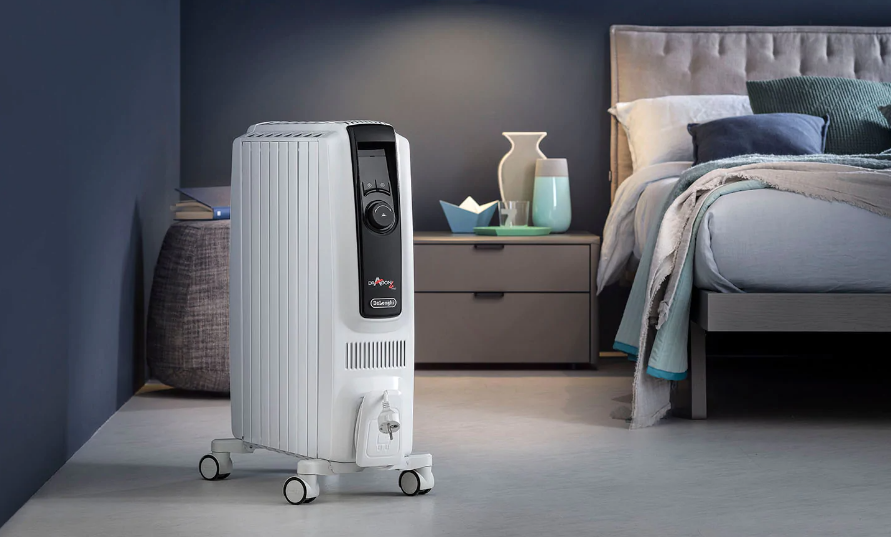
DeLonghi 2507L Electric Heater
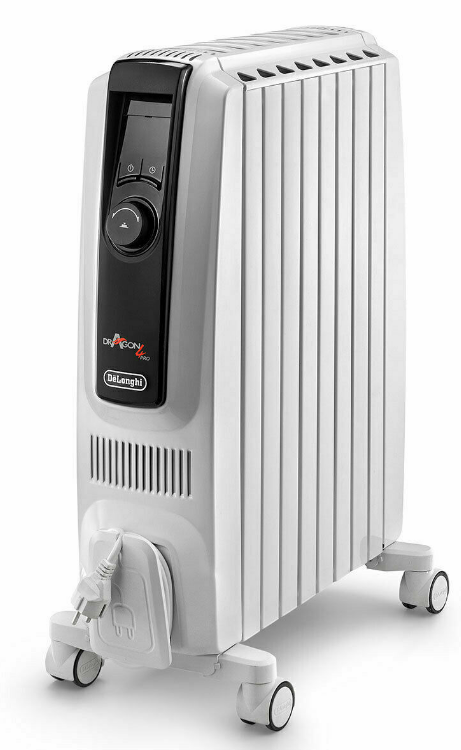
IMPORTANT SAFEGUARDS
- Read all instructions before using this heater.
- If your radiator is equipped with a polythene tape used as a carry handle, remove it before connecting the appliance to the outlet.
- This heater is hot when in use. To avoid burns, do not let bare skin touch hot surfaces. Use the handle when moving this heater. Keep combustible materials, such as furniture, pillows, bedding, papers, clothes, and curtains at least 3 feet (0,9 m) from the front and top of the heater and keep them away from the sides and rear.
- Extreme caution is necessary when any heater is used by or near children and whenever the heater is left operating and unattended.
- Always unplug the heater when not in use.
- If the supply cord is damaged, it must be replaced by the manufacturer, its service agent, or similarly qualified persons in order to avoid a hazard.
- Do not operate any heater with a damaged cord or plug, or after the heater malfunctions, has been dropped or damaged in any manner. If the heater has leaked any oil, discontinue using the heater and contact the service center as indicated in the instruction leaflet. Return the heater to the authorized service facility for examination, electrical or mechanical adjustment, or repair.
- Do not use outdoors.
- This heater is not intended for use in bathrooms, laundry areas, or similar indoor locations. Never locate the eater where it may fall into a bathtub or other water container.
- Do not run the cord under carpeting. Do not cover the cord with throw rugs, runners, or the like. Arrange the cord away from the traffic area and where it will not be tripped over.
- To disconnect the heater, turn the controls to off, then remove the plug from the outlet.
- Connect to properly polarized outlets only.
- Do not insert or allow foreign objects to enter any ventilation or exhaust opening, as this may cause an electric shock, fire, or damage the heater.
- To prevent a possible fire, do not block air intakes or exhaust in any manner. Do not use on soft surfaces, like a bed, where openings may become blocked.
- A heater has hot or arcing, or sparking parts inside. Do not use it in areas where gasoline, paint, or flammable liquids are used or stored.
- Use this heater only as described in this manual. Any other use not recommended by the manufacturer may cause fire, electric shock, or injury to persons.
- To prevent overload and blown fuses, be sure that no other appliance is plugged into the same outlet (receptacle) or another outlet (receptacle) wired into the same circuit.
- It is normal for the heater’s plug and cord to feel warm to the touch. A plug or cord that becomes hot to the touch or distorted in shape may be a result of a worn electrical outlet. Worn outlets or receptacles should be replaced before further use of the heater. Plugging a heater into a worn outlet /receptacle/ may result in overheating of the power cord or fire.
- Do not use an extension cord because it may overheat and pose a risk of fire risk. However, if you must use an extension cord, it shall be a minimum size of No. 14 AWG and rated for not less than 1875 watts, and it must be used only for supplying power to this heater.
- Ensure the plug is fully inserted into a suitable outlet. Please remember that outlets also deteriorate due to aging and continuous use: check periodically if signs of overheating or deformations are evidenced by the plug. Do not use the outlet and CALL your electrician.
- Check that neither the appliance nor the power cable has been damaged in any way during transportation.
- Make sure that no pieces of polystyrene or other packaging material have been left
between one element of the appliance and another. It may be necessary to pass over the appliance with a vacuum cleaner. - When switching on the appliance for the first time, allow it to run at full power for about two hours to get rid of the unpleasant smell. Make sure that the room in which the appliance is located is well ventilated during this operation. It is normal for the appliance to emit small cracking sounds when you turn it on for the first time.
HOW TO USE YOUR HEATER
FITTING THE WHEEL
Remove the feet and the wheels from the polystyrene packing. Turn the radiator upside down on a rug or a soft surface to prevent damaging the paint finish.
- Fit the wheels to the spindles on the feet and push firmly until they click into position. Pull each wheel to check that it is correctly inserted.
- The feet with the casters must be fitted with two arc-shaped brackets, and fit them
using the threaded bar and wing nut provided, only between the 1st and 2nd element and the second to last (see fig. 1 to 3 inclusive
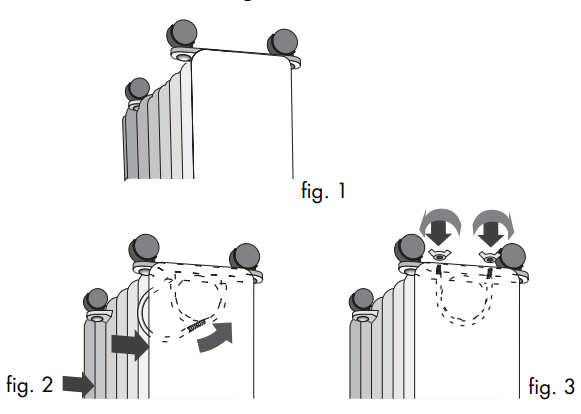
MODELS WITH “EASY WHEEL” SYSTEM
Turn the radiator upside-down on a rug or a soft surface to prevent damaging the paint finish. Fully unfold the castors by turning them outwards (Fig. 4). Turn the radiator back to its upright position.
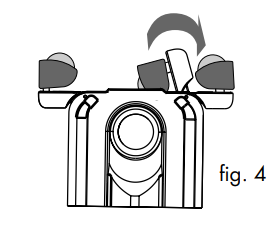
- LOCATION: Place the heater on the floor beneath the coldest window in the room, or any other location. Your heater will reduce the effect of cold drafts. The heater should not be placed immediately below a power outlet. Do not use this radiator in rooms with a floor area of less than 43 square feet (4 sq. m.).
- CONNECTION: The radiator should be connected to a properly polarized A/C 110/120 V household outlet in perfect working conditions. Keep loose clothing or bedding, furniture, and flammable material away from the heater’s wall outlet.
- TURNING ON TWO-SWITCH MODELS: Turn the thermostat clockwise to its maximum position. Push down both switches. The switch lights stay on independently of the thermostat cycling. When room reaches the desired temperature, turn the thermostat knob counter-clockwise very slowly and carefully until you hear a click. This should set your heater to maintain the desired temperature by cycling on and off as required. (For timer instructions, see paragraph 5.) Note: The heater normally requires about 15 minutes to reach the desired temperature.
- USE OF THERMOSTAT: The thermostat operates according to room air temperature, rather than radiator temperature. Turning it counter-clockwise to smaller numbers would decrease the temperature; clockwise to greater numbers would increase the temperature.
- UNITS WITH TIMER(Clock setting): The program/timer, as with all clocks, must be set to the correct time. If, for example, the time is 9.30 a.m. (day zone), rotate the dial clockwise (following the direction of the arrow) until 9.30 is aligned with the triangular pointer.
HOW TO USE THE TIMER
Please refer to the illustration below:
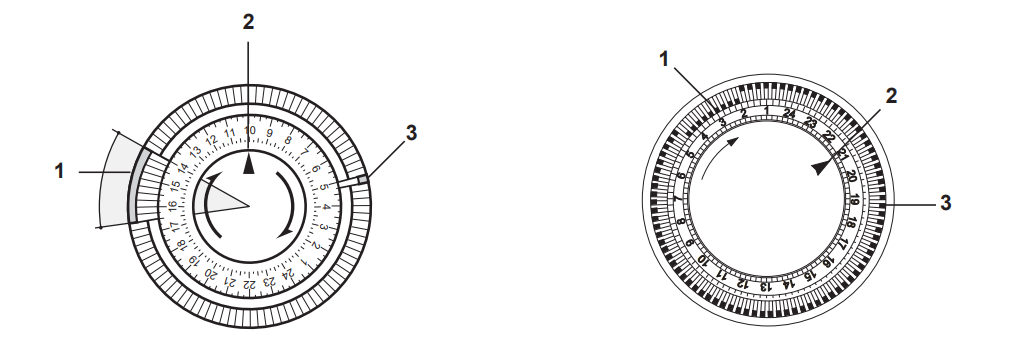
IMPORTANT: There are 96 tabs around the dial. Each tab represents a 1/4 hour (15 minutes), and there is a tab for each quarter hour of the day (24 hours). Your appliance can be programmed to switch itself ON and OFF at the time of your choice. With a timer, you can approximate your setting to within 15 minutes and program up to 48 cycles (1 cycle = 1 “ON” + 1 “OFF”) over 24 hours (12 hours a.m.+12 hours p.m.). The tabs can be pushed inwards or pulled outwards simply by using your fingers. When a tab is in the inward position (towards the center of the dial), the heater will be on during the corresponding 15-minute period. If a tab is in the outward position, the heater will be off during that period. Please note that when you first use your heater, all the tabs are out. You must push in the tabs that correspond to the period when you want the heater to be on. (If you want to bypass the timer, you must push all 96 tabs inward.)
Timer operation
- A) Plug in the heater.
- B) Turn the timer dial clockwise to set the clock to the current time of day (see CLOCK SETTING).
- C) Push tabs inwards for the period you want the heater to operate. For example, in the shown illustration, the heater will operate from 14.00 (2 p.m.) to 16.30 (4.30 p.m.) and from 4.45 a.m. to 5 a.m.
- D) Push switch(-es) in.
- E) Once you have set the tabs for the desired heating periods, your heater will cycle on and off according to these settings.
- F) As long as you keep the heater plugged in, the timer will maintain the proper time.
A safety device: A safety device switches the heater off in the event of overheating. To restart the heater, call the nearest Service center.
MAINTENANCE AND SERVICE
Always unplug the heater from the power outlet and allow the radiator to cool. Wipe the radiator with a soft, damp cloth; do not use detergents and abrasives. Should the radiator not be in use for a certain length of time, roll the cable around the holder and store it in a dry place (see fig. on front page). This appliance has been built to last for many years of trouble-free service. In case of malfunction or doubt, do not try to repair the heater by yourself: this might increase the risk of fire and electric shock. Call the nearest Service Center. Visit www.delonghi.com for a complete list of Service Centers (U.S. only).
FOR MORE MANUALS BY DELONGHI, VISIT MANUALSLIBRARYY
DeLonghi 2507L Electric Heater-FAQs
How much power does the DeLonghi 2507L heater use?
The DeLonghi 2507L typically uses 1500 watts on its highest setting. Lower settings consume less power.
How do I operate my DeLonghi electric heater?
Plug into a wall outlet (avoid extension cords).
Turn the thermostat dial to your desired temperature.
Select heat level (low, medium, or high).
Use Comfort Temp mode (if available) for automatic temperature regulation.
Why does my DeLonghi heater keep turning off?
Possible reasons:
Overheating due to dust buildup (clean with compressed air).
Thermostat setting too low (adjust to a higher temp).
Safety auto-shutoff activates if tipped over or obstructed.
What is the “Comfort Temp” button?
This mode maintains a preset temperature (72°F/22°C) for energy efficiency and consistent warmth.
Are DeLonghi heaters energy efficient?
Yes! They use radiant heating (no fan) and adjustable thermostats to minimize energy waste.
How many electricity units does this heater consume?
1 hour on high (1500W) = 1.5 kWh (~$0.20/hour, depending on rates).
Lower settings or Eco Mode reduce consumption.
How long does it take to heat up?
About 5–10 minutes to reach full warmth, depending on room size and temperature setting.
What is Eco Mode?
Eco Mode optimizes energy use by reducing power when the room reaches the desired temperature.
How do I maintain my DeLonghi heater?
Unplug and cool before cleaning.
Wipe with a dry cloth (no water or chemicals).
Use a vacuum to remove dust from vents.

